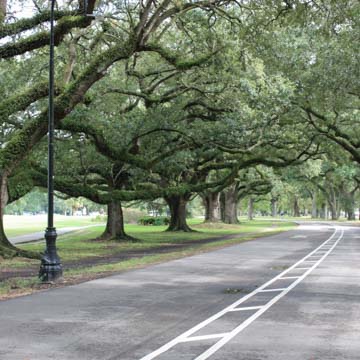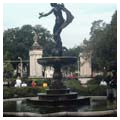Established in 1886 on the site of the World’s Industrial and Cotton Centennial Exposition of 1884, this major park was named in honor of naturalist and bird painter John James Audubon (1780–1851), who lived for a short time in New Orleans. Audubon Park now encompasses more than three hundred acres and stretches to the Mississippi River. The Exposition grounds were the former sugar plantation of Jean Etienne de Boré, who in 1795 developed a method for granulating sugar that could be employed on a commercial scale. Prior to the 1884 Exposition, the plantation had housed the occupying Union Army during the Civil War. The Exposition’s most notable structure was Horticulture Hall, modeled on Joseph Paxton’s Crystal Palace in London of 1851, and destroyed by an early-twentieth-century hurricane.
Around the turn of the twentieth century, the Olmsted office was engaged to design the park. In an effort to give the flat site a luxuriant and southern picturesque effect, John Charles Olmsted, Frederick Law Olmsted’s nephew and stepson, designed a scheme for the park that included lagoons, bridges, copses, and regional plants. The park’s central section is now occupied by a refurbished “executive” golf course (replacing the original 1920s course), which restricts most public activities to the park’s perimeter, where tree-lined paths attract strollers and skaters. It took many years to complete the park’s landscaping; the lagoon at the St. Charles Avenue end was not finished until 1918. Two pairs of monumental stone pylons, designed by Moise Goldstein in 1921, mark the park’s entrances on St. Charles Avenue. Isidore Konti (1862–1938) sculpted the attractive bronze Gumbel Fountain (1918) just inside this entrance. Emile Weil designed the oval Newman Memorial Bandstand in 1921. In 1924, the park gained an additional fifty acres following the closing of the Louisiana Sugar Experiment Station, built in 1890, and the zoo (OR180) was located here. In 1969, the forty-acre riverfront park, part of the original Olmsted plan, was created from landfill.




















